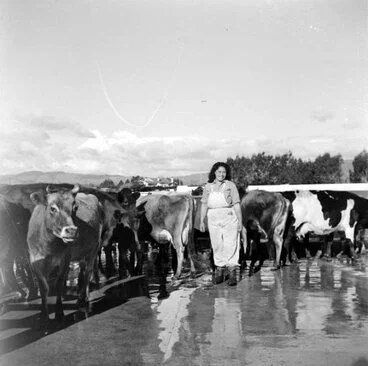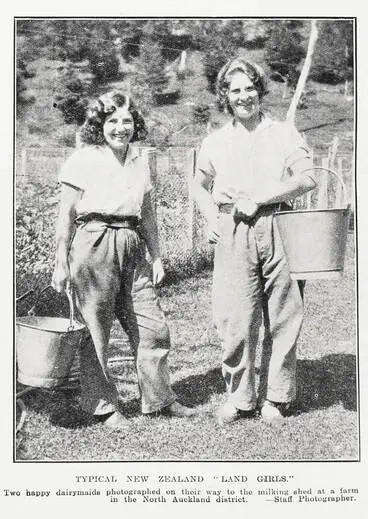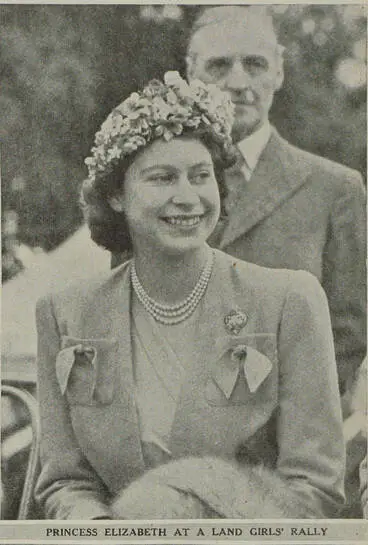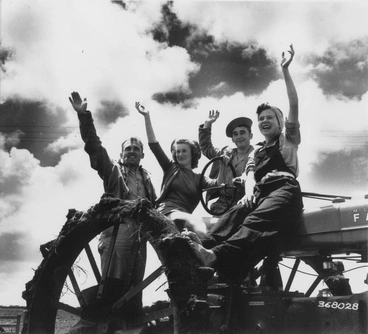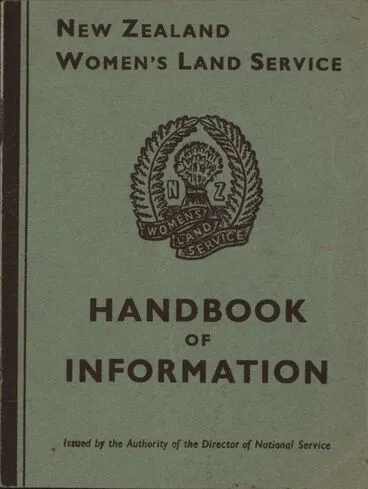Land Girls
A DigitalNZ Story by Allie Ruhlander
Kiwi Women in WWII
During World War II, women across the world, including here in New Zealand, were experiencing drastic changes to their daily lives. As more men were enlisting, women found themselves doing jobs that had historically been considered men’s work. The agriculture industry was one area where the service of women was vital. Ideas about female identity in Kiwi culture experienced a change during this period as women were increasingly employed in traditionally masculine fields of work.
In 1942, as provisions became sparse, the Women’s War Service Auxiliary and the National Service Department officially formed the Women’s Land Service [Montgomerie, 1989, p4]. The service had to take on the task of providing for domestic and British citizens as well as the arrival of around 100,000 American soldiers in New Zealand and the Pacific [Bardsley, 2000, p11].
Life on a Dairy Farm
Kiwi land girls could find themselves milking nearly 80 cows every day.
Manatū Taonga, the Ministry for Culture and Heritage
Oral Histories from Former Land Girls
This is a radio clip of women recounting their experiences on the farms.
Radio New Zealand
8 Hour Minimum Work Day
Women in the Land Service worked long hours and rarely had time off.
Auckland Libraries
The women in the service, more commonly known as land girls, wanted to provide support in times of war as well as free up men for fighting. The girls who enlisted were from rural and urban areas alike. Some had grown up on farms, watching their fathers before them, whereas others had never seen a plough. Whether they were experienced sheep shearers or novice farmhands, they felt the call to serve their country any way possible, much like the men. When the Land Service was first formed, women were less inclined to join because other women’s war services provided more stable conditions and support [Bardsley, 2000, p13]. However, efforts were made to recruit more land girls by improving wages and providing them with a “smart chocolate uniform” [Montgomerie, 1989, p4].
Land girls worked long hours, often from before sunrise to late in the evening. They seldom had a day off. As Sadie Lietze recalls, “I milked cows morning, night – every day of the year and never had a break. You would get Saturday afternoon off to do your washing” [1].The work was physically and mentally taxing. Women often found themselves shearing, slaughtering, milking, gardening, and working the fields. Due to cutbacks for the war effort, most rural areas went without electrical power, meaning the field work was done without tractors but rather with a horse and plough.
Interview with Jai Hall
She discusses her bronze bells memorial and the delayed recognition of the hundreds of Kiwi land girls.
Radio New Zealand
Interview with Dianne Bardsley
She is the author of The Land Girls: In a Man's World, 1939-1946.
Radio New Zealand
Land Girls Held a Variety of Different Tasks
These could include working with livestock as well as in the fields.
Manatū Taonga, the Ministry for Culture and Heritage
Despite the fact that these women were working with fewer resources and farmhands, the production of wool and most meat was at a record high; how did nearly 4,000 women replace 28,000 men and still manage to thrive under such difficult wartime conditions [2]? The land girls were faced with considerable opposition from both the New Zealand government as well as the farmers they worked with [Montgomerie, 2001, p49]. At this time, there was not unity of identity for many Kiwis, for they were divided on the issue of accepting the land girls. The women in the land service had been officially enlisted in the organization but were not recognized or appreciated for their efforts.
In 1943, the First Lady of the United States, Eleanor Roosevelt, come to visit New Zealand. While here, she visited some land girls on the farms and recognized them for their hard work and dedication. During the war, New Zealand media referred to the efforts of these women as “excellent” and “splendid” [Bardsley, 2000, p130]. However, this sentiment did not remain once the war was over. The New Zealand government did not want to foster the notion that women could effectively replace the men as they were beginning to return from their service [Montgomerie, 1989, p13]. This idea caused the efforts of these women to be subdued in the eyes of the New Zealand public. In contrast, the efforts of Britain’s land girls, such as Margaret Reid, were recognized with certificates from the Princess Elizabeth, who would later become Queen, soon after WWII ended [3].
“We only did what was expected, we got on with it.” Those were the words inscribed on the bronze memorial bells that Jai Hall made. In a 2013 interview with Radio New Zealand [see DigitalNZ above], the artist talks about how these women fearlessly took on the task of serving their country; however, it took many years before their efforts were even recognized. At the end of the war, the land girls were forgotten by the government and most records discarded [4]. While the men returned from war and were showered with recognition, the land girls were simply displaced. Hall emphasized that it was not until 2011 that they were given certificates, and by then many former land girls had passed away.
Princess Elizabeth and her support of the land girls in Britain.
In England, the efforts of the land girls were recognized with official certificates.
Auckland Libraries
U.S. First Lady Eleanor Roosevelt Visited NZ during the war.
While here, she spent time on rural farms meeting local Kiwi land girls.
Manatū Taonga, the Ministry for Culture and Heritage
Media Portrayal of the Land Girls
... shifted over the course of WWII as sentiments about their efforts were suppressed by farmers and the government.
Manatū Taonga, the Ministry for Culture and Heritage
Pictured here are land girls with American soldiers.
The land girls had the task of providing for Kiwi, British, and American soldiers.
Manatū Taonga, the Ministry for Culture and Heritage
This was the official handbook for the women serving as land girls.
It contained rules and information for members, including duties, wages, and placement.
Palmerston North City Library
Did these wartime changes lead to a dramatic shift in ideas about gender equality here in New Zealand? I would argue partially. When the men returned, there was pressure for life to return to that of times before the war. However, the land girls set in motion a new mindset about the sexual division of labour. The years of hard work on the farms had given women “satisfaction which came from crossing the barrier… gave women a strong sense of achievement with which to face public disapproval” [Montgomerie, 1989, p12]. The notion that farm work was considered a man’s job had been set aside during the war, giving Kiwi women a chance to assert themselves as equals. This initial opposition to the unfair treatment had a great historical influence.
During the war, women were consistently getting less in wages and recognition than the men. Sheila Smith, a former land girl, expressed in an interview that “because you were a woman you got much less than the men” [5]. Today, New Zealand is seen as a country with progressive ideals and consistently has one of the lowest gender pay gaps when comparing full time employees [6]. Women have had a rich history in New Zealand, from its becoming the first independent country to allow women the right to vote to having a woman, Jacinda Ardern, as prime minister. The tenacity of Kiwi women, in both the past and present, to fight for their rights is inspiring.
Sheep Farming
Land girls learned many new skills including shearing, milking, and how to drive a tractor, if the farm had one.
Alexander Turnbull Library
It took many years for these women to be recognized for their service.
It was not until 2011 that the NZ government gave former land girls certificates.
Museum of New Zealand Te Papa Tongarewa
The Land Girls Contributed to the War Effort
These women provided support for one another, even many years following the war.
Museum of New Zealand Te Papa Tongarewa
Bibliography
Bardsley, Dianne. The Land Girls: In a Man’s World, 1939-1946. (Dunedin: University of Otago Press, 2000).
McKenzie-McLean, Jo. Land Girls, New Zealand’s World War II unsung heros. https://www.stuff.co.nz/southland-times/news/103240807/land-girls-new-zealands-world-war-ii-unsung-heroes.
Ministry for Women. New Zealand women. https://women.govt.nz/about/new-zealand-women.
Montgomerie, Deborah. Men’s Jobs and Women’s Work: The New Zealand Women’s Land Service in World War II. (Agricultural History, summer 1989).
Montgomerie, Deborah. The Women’s War: New Zealand Women 1939-45. (Auckland: Auckland University Press, 2001).
Parr, Alison. You got much less than the men. https://nzhistory.govt.nz/media/sound/you-got-much-less-men.
